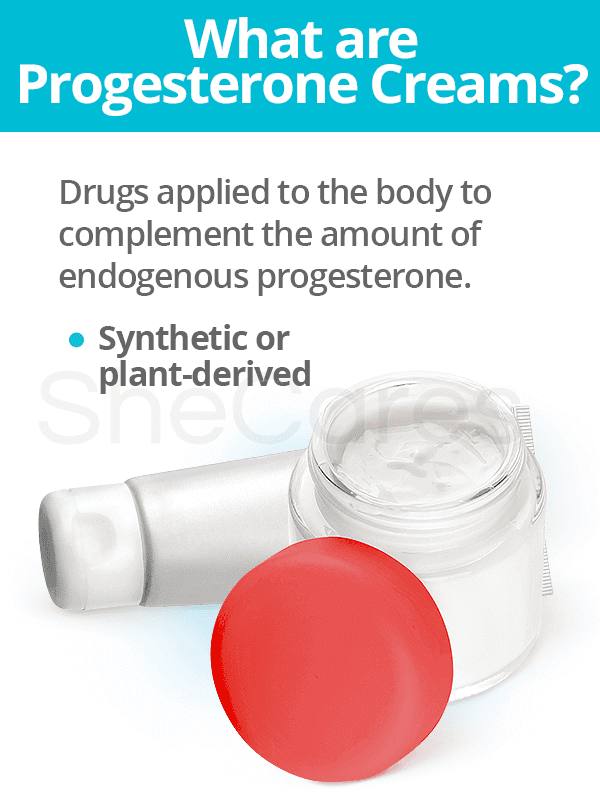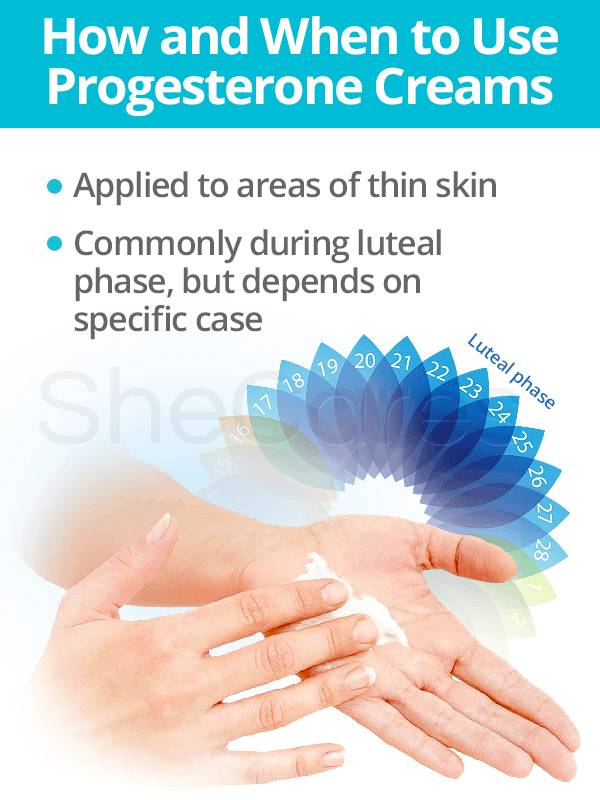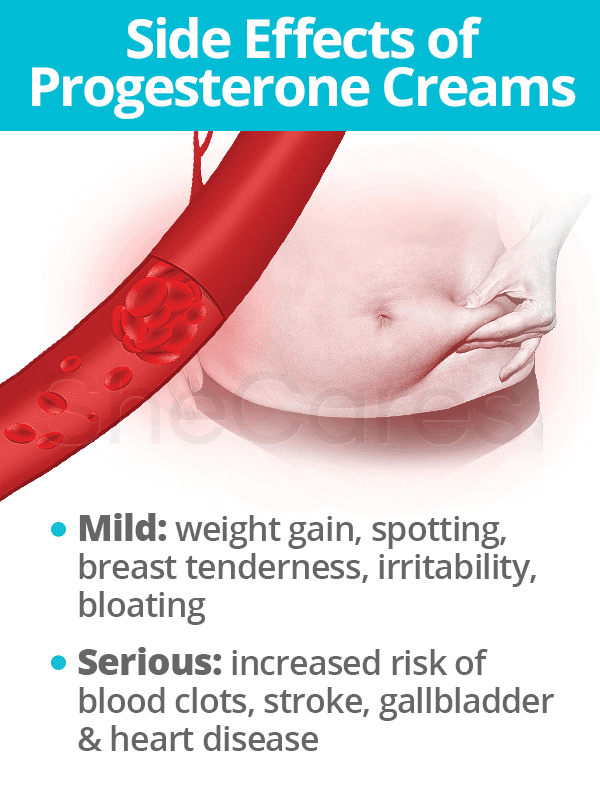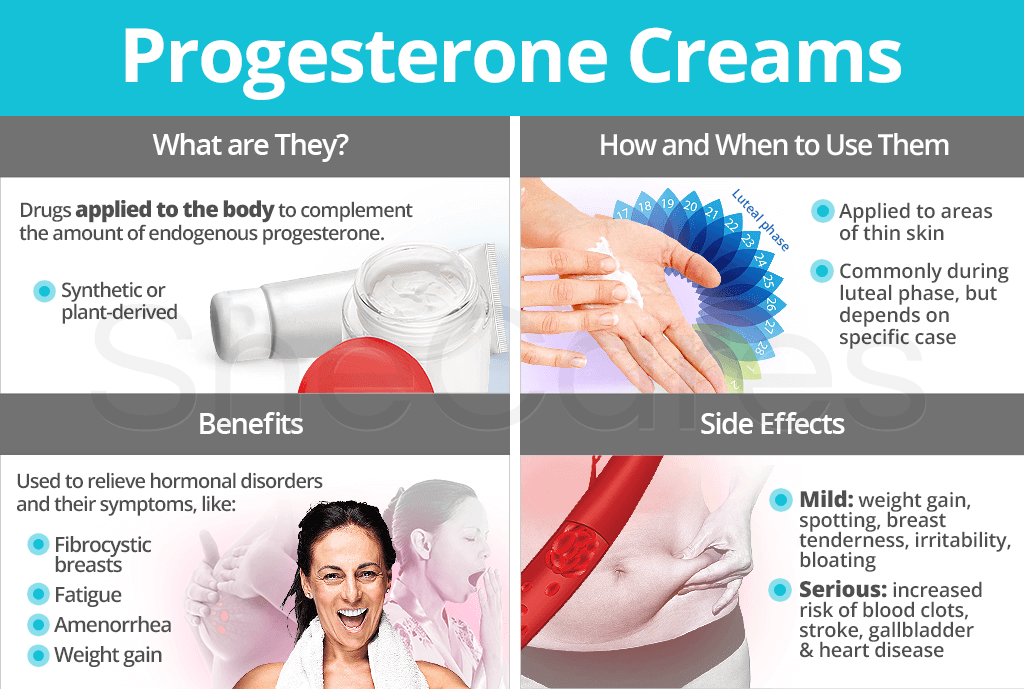There are a variety of progesterone medications women can undergo to increase progesterone levels for ultimate hormonal balance. Each medication comes with its own list of benefits and side effects as well as recommendations for use.
Continue reading to learn more about progesterone creams and what they are used for as well as how and when to use them for the best outcome.
What is Progesterone Cream?

Progesterone creams are drugs used to complement progesterone in the body. There are two types:
Synthetic progesterone creams. This type of progesterone cream contains concentrations of synthetically produced progesterone, also known as progestin. Progestin causes some or all of the biological effects of endogenous progesterone.
Plant-derived progesterone creams. United States Pharmacopia (USP) natural progesterone cream - or bioidentical progesterone cream - is derived from plant sterols stigmasterol and diosgenin, which are isolated from soy and wild Mexican yam, respectively. In laboratories, these sterols are converted to pregnenolone, a principal precursor to steroid hormones, and then to progesterone.
What is Progesterone Cream Used For?
In general, progesterone cream is used to treat hormonal imbalances and alleviate disorders such as PMS, estrogen dominance, and infertility. It is also used to relieve perimenopausal and postmenopausal symptoms.
Progesterone Cream Benefits
Progesterone cream is used for a variety of situations in which women's hormones are off balance, affecting a healthy menstrual cycle, pregnancy, and more.
For women of all ages, progesterone cream is often used to treat hormonal disorders and their symptoms, such as:

- Fibrocystic breasts
- Fatigue
- Memory loss
- Thyroid problems
- Uterine fibroids
- Insomnia
- PCOS
- Endometriosis
- Weight gain
- Amenorrhea (absence of menstruation)
- Hot flashes and night sweats
- Mood swings
- Irritability
- Vaginal dryness
- And many more
Moreover, progesterone cream helps expand the cervix when applied inside the vagina, treats breast pain in women with noncancerous breast disease, and prevents abnormal thickening of the uterine lining.
Progesterone cream is often favored over other progesterone products - pills, suppositories, injections, etc. - because it easily enters the bloodstream. Through ingestion, such as with progesterone pills, it first has to go through the liver, where much of it is metabolized and excreted prior to yielding any benefit.
How and When to Use Progesterone Cream
How Do I Use Progesterone Cream?

Progesterone cream is fat-soluble and is best absorbed where the skin is thin and well supplied with capillary blood flow. These areas include the inner arms and thighs, upper chest, lower back, palms of the hands, breasts, and throat.
The hormone is then stored in fatty tissues until required for use. Once fatty tissues are saturated, there is an increase in blood progesterone levels, causing a stronger physiological effect.
Because progesterone cream allows for up to 12 hours of sustained delivery, it is recommended to apply it twice daily, half in the morning and half at night. It is important to rotate sites of application each time and - in most cases - to apply no more than 20 to 30 mg daily.
When Do I Use Progesterone Cream?
Women use progesterone creams at different times, depending on their hormonal situations. The most common dosage involves using the cream during the second half of the menstrual cycle, which is when progesterone levels should be higher. After menopause, women usually use the progesterone cream continuously.
Progesterone Cream Side Effects

Common side effects of overuse include weight gain, spotting, breast tenderness, irritability, bloating, cramping, acne, insomnia, tiredness, blurred vision, mood swings, and excessive hair.
There may also be local irritation as the area where progesterone cream is applied may itch or turn red. Some doctors may claim bioidentical hormones - natural progesterone - are safer, but research proving so has yet to be revealed.
Specific use, such as part of infertility treatments and during pregnancy, is generally safe because it is short term with continuous monitoring by a doctor.
Serious side effects that evolve from use of exogenous hormones during HRT include an increased risk of blood clots; stroke; gallbladder and heart disease; and breast cancer.
Where Do I Buy Progesterone Cream?
Synthetic and natural progesterone cream can be acquired with a doctor's prescription or over the counter at pharmacies, health food stores, and major online retailers.
If buying progesterone cream over the counter or online, it is wise to consult with a doctor for proper dose instructions beforehand. Improper usage can lead to a variety of unwanted side effects.
Two of the most popular natural progesterone creams are known as Emerita Pro-Gest® and ProgesterAll™. Both Emerita Pro-Gest® progesterone cream and ProgesterAll™ are derived from wild Mexican yam. Each cream contains 450 and 480 mg of USP progesterone per ounce, respectively, and allots for a standardized 20 mg per quarter teaspoon.
Key Takeaways
Overall, progesterone cream can be used as a supplement to replace progesterone missing in the body. It is used to treat the underlying cause and symptoms for a variety of hormonal disorders. Generally applied to the skin during the second half of one's menstrual cycle, the cream sits in fatty tissues until needed by the body. Keep in mind that overuse of this progesterone medication can evoke unwanted side effects. Progesterone creams can be obtained with a prescription or over the counter.
However, to avoid the use of pharmaceutical treatments that carry certain risks, learn more about natural progesterone supplements, which include herbal options.
Sources
- Apgar, B.S. & Greenberg, G. (2000). Using Progestins in Clinical Practice. American Family Physician, 62(8), 1839-1846. Retrieved October 28, 2019, from https://www.aafp.org/afp/2000/1015/p1839.html
- Cleveland Clinic. (2014). Bioidentical Hormones | Hormone Therapy. Retrieved October 28, 2019, from https://my.clevelandclinic.org/health/articles/15660-bioidentical-hormones | https://my.clevelandclinic.org/health/treatments/15245-hormone-therapy
- Fugh-Berman, A. (1999). Wild Yam Cream, Diosgenin, and Natural Progesterone: What Can They Really Do for You? Retrieved January 16, 2018, from https://www.nwhn.org/wild-yam-cream-diosgenin-and-natural-progesterone-what-can-they-really-do-for-you/
- House, M. et al. (2014). Inhibitory Effect of Progesterone on Cervical Tissue Formation in a Three-Dimensional Culture System with Human Cervical Fibroblasts. Biology of Reproduction, 90(1), 18. doi: 10.1095/biolreprod.113.112540
- Martin, R. & Gerstung, J. (2005). The Estrogen Alternative: A Guide to Natural Hormonal Balance, Fourth Edition. Vermont: Healing Arts Press. Available from Google Books.
- Mayo Clinic. (2015). Hormone therapy: Is it right for you? Retrieved October 28, 2019, from https://www.mayoclinic.org/diseases-conditions/menopause/in-depth/hormone-therapy/art-20046372
- National Women's Health Resource Center. (n.d.). Progesterone. Retrieved October 28, 2019, from http://www.healthywomen.org/condition/progesterone
